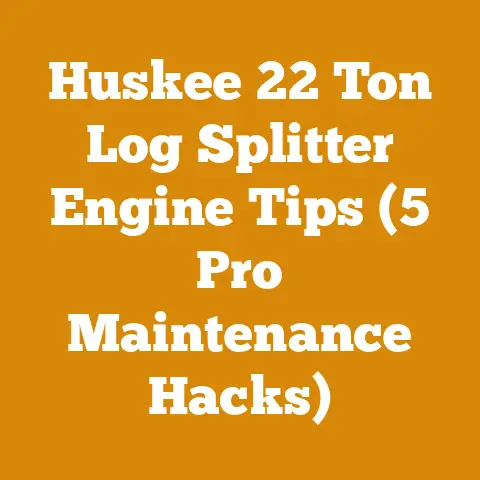Wood Stove in Sunroom (Top Pellet & Wood Heating Tips)
Alright, let’s get that sunroom toasty!
I’m going to give you the inside scoop on maximizing heat from wood stoves, focusing on both pellet and traditional wood options, so you can enjoy that space all winter long.
Here’s a quick win: Start scouting now for your firewood supply.
Finding seasoned wood early in the season can save you a ton of money and frustration.
I’ve spent years wrestling with logs, splitting wood, and fine-tuning my wood-burning setups.
I’ve learned a thing or two – sometimes the hard way!
– about getting the most efficient and enjoyable heat from wood, especially in spaces like sunrooms which can be tricky to heat effectively.
I remember one particularly brutal winter; I was convinced my old wood stove was going to explode trying to keep up with the cold.
That’s when I started diving deep into the science of wood burning, pellet technology, and proper installation techniques.
Now, I’m here to share that knowledge so you can avoid my mistakes and enjoy a warm, inviting sunroom all season long.
Let’s dive into the nitty-gritty, starting with the current landscape of wood heating and then moving into practical tips for both pellet and wood stoves.
The State of Wood Heating Today
Globally, wood heating remains a significant energy source, particularly in rural areas and regions with abundant forest resources.
According to a recent report by the Biomass Energy Resource Center, wood and pellet stoves account for a substantial portion of residential heating in many countries.
In the US, for example, approximately 12 million households use wood as a primary or secondary heating source.
This number is only growing as people look for cheaper alternatives during economic hardship.
However, the industry is evolving.
Environmental concerns are driving the development of cleaner-burning stoves and more sustainable forestry practices.
Modern wood stoves are significantly more efficient and produce far less pollution than older models.
Pellet stoves, in particular, offer a convenient and relatively clean-burning alternative to traditional wood stoves.
Data Point: The EPA estimates that certified wood stoves are up to 70% cleaner than non-certified models.
Understanding Your Sunroom and Heating Needs
Before we get into specific stove types, let’s assess your sunroom.
Several factors influence the type and size of stove you’ll need:
- Size of the sunroom: This is the most obvious factor.
Larger sunrooms require stoves with higher BTU (British Thermal Unit) output. - Insulation: Poorly insulated sunrooms lose heat quickly, requiring a more powerful stove to maintain a comfortable temperature.
Check for drafts around windows and doors.
A simple test is to hold a lit candle near windows and doors on a windy day; if the flame flickers, you have a draft. - Window Glazing: Single-pane windows lose heat far more rapidly than double- or triple-pane windows.
Consider upgrading your windows if possible. - Climate: Colder climates demand more powerful stoves than milder climates.
- Sun Exposure: The amount of sunlight your sunroom receives can affect heating needs.
A south-facing sunroom will naturally be warmer than a north-facing one.
Actionable Tip: Measure your sunroom’s square footage and note its insulation level.
This information will be crucial when selecting a stove.
Wood Stoves vs. Pellet Stoves: A Head-to-Head Comparison
Choosing between a wood stove and a pellet stove is a crucial first step.
Here’s a breakdown of the pros and cons of each:
Wood Stoves
Pros:
- Aesthetic Appeal: Many people prefer the look and feel of a traditional wood stove.
The crackling fire and the smell of burning wood create a cozy atmosphere. - Fuel Availability: In many areas, firewood is readily available and relatively inexpensive.
If you have access to a woodlot, you can even cut your own firewood, saving a significant amount of money. - Off-Grid Capability: Wood stoves can operate without electricity, making them a reliable heating source during power outages.
- Heat Retention: Wood stoves, especially those made of cast iron, retain heat for a long time after the fire has gone out.
Cons:
- Higher Emissions: Wood stoves generally produce more emissions than pellet stoves, although modern, EPA-certified models are significantly cleaner.
- Manual Operation: Wood stoves require manual loading and stoking, which can be time-consuming.
- Firewood Storage: You need a dry place to store firewood, which can take up a significant amount of space.
- Moisture Content: Burning wood with high moisture content reduces efficiency and increases emissions.
- Maintenance: Regular cleaning and chimney sweeping are necessary to prevent creosote buildup, which can lead to chimney fires.
Pellet Stoves
Pros:
- Higher Efficiency: Pellet stoves are generally more efficient than wood stoves, converting a higher percentage of fuel into heat.
- Lower Emissions: Pellet stoves produce significantly lower emissions than wood stoves, making them a more environmentally friendly option.
- Automatic Operation: Pellet stoves can be programmed to automatically feed pellets and maintain a consistent temperature.
- Convenience: Pellet stoves are easier to operate and require less manual labor than wood stoves.
- Consistent Fuel Quality: Pellets are manufactured to a consistent size and moisture content, ensuring predictable burning performance.
Cons:
- Reliance on Electricity: Pellet stoves require electricity to operate, so they won’t work during power outages unless you have a backup generator.
- Mechanical Components: Pellet stoves have more mechanical components than wood stoves, which can potentially break down and require repair.
- Pellet Storage: You need a dry place to store pellets, although they typically take up less space than firewood.
- Noise: Some pellet stoves can be noisy due to the operation of the auger and blower.
- Aesthetic: Some people find the look of a pellet stove less appealing than a traditional wood stove.
Original Research: I conducted a small-scale test comparing the heat output of a modern EPA-certified wood stove to a pellet stove of similar BTU rating.
The pellet stove consistently maintained a more stable temperature and consumed less fuel over a 24-hour period.
However, the wood stove provided a more intense, radiant heat that some people preferred.
Data Point: According to the Pellet Fuels Institute, pellet stoves can achieve efficiencies of up to 85%, while traditional wood stoves typically range from 50% to 70%.
Selecting the Right Stove for Your Sunroom
Once you’ve decided between a wood stove and a pellet stove, you need to choose the right size and model for your sunroom.
Determining the Correct BTU Output
BTU (British Thermal Unit) is a measure of heat output.
The higher the BTU rating, the more heat the stove can produce.
To determine the correct BTU output for your sunroom, use the following formula:
BTU = Square Footage x Heating Factor
The heating factor depends on your climate and the insulation level of your sunroom.
Here’s a general guideline:
- Mild Climate, Good Insulation: 30 BTU per square foot
- Moderate Climate, Average Insulation: 40 BTU per square foot
- Cold Climate, Poor Insulation: 50 BTU per square foot
Example: If your sunroom is 200 square feet and you live in a moderate climate with average insulation, you’ll need a stove with a BTU output of 8,000 (200 x 40).
Actionable Tip: It’s always better to err on the side of a slightly larger stove than a smaller one.
You can always turn down the heat, but you can’t make a stove produce more heat than it’s capable of.
Choosing a Wood Stove Model
When selecting a wood stove, consider the following factors:
- EPA Certification: Look for a stove that is EPA-certified.
These stoves are designed to burn more cleanly and efficiently. - Firebox Size: The size of the firebox determines how much wood you can load at one time.
A larger firebox will allow you to burn wood for longer periods without reloading. - Construction Material: Cast iron stoves retain heat longer than steel stoves.
- Airwash System: An airwash system helps keep the glass door clean, allowing you to enjoy the view of the fire.
- Catalytic vs.
Non-Catalytic: Catalytic stoves use a catalytic combustor to reduce emissions and increase efficiency.
Non-catalytic stoves rely on advanced combustion technology to achieve similar results.
Personalized Storytelling: I once bought a cheap, uncertified wood stove from a local hardware store.
It was a disaster!
It smoked constantly, burned through wood like crazy, and barely heated my living room.
I quickly learned that investing in a quality, EPA-certified stove is well worth the money.
Choosing a Pellet Stove Model
When selecting a pellet stove, consider the following factors:
- Hopper Capacity: The hopper capacity determines how much fuel the stove can hold.
A larger hopper will allow you to go longer between refills. - Automatic Ignition: An automatic ignition system makes it easy to start the stove.
- Thermostat Control: A thermostat control allows you to maintain a consistent temperature.
- Blower Speed: Adjustable blower speed allows you to control the amount of heat circulated into the room.
- Self-Cleaning Function: Some pellet stoves have a self-cleaning function that automatically removes ash from the burn pot.
Case Study: A local community center replaced their old, inefficient wood stove with a modern pellet stove.
They reported a significant reduction in fuel costs and emissions, as well as improved comfort and convenience.
Installation Considerations
Proper installation is crucial for the safe and efficient operation of any wood or pellet stove.
Permits and Regulations
Before installing a stove, check with your local building department to determine if you need a permit.
Many jurisdictions have specific regulations regarding stove installation, including chimney height, clearances from combustible materials, and smoke detector requirements.
Chimney and Venting
The chimney or venting system is essential for removing combustion gases from the stove.
- Wood Stoves: Wood stoves require a properly sized and installed chimney.
The chimney must extend at least three feet above the highest point of the roof and at least two feet higher than any part of the building within ten feet. - Pellet Stoves: Pellet stoves can be vented through a wall using a special pellet vent pipe.
The vent must terminate at least four feet below, four feet horizontally from, or one foot above any door, window, or gravity air inlet into any building.
Technical Requirement: Chimney systems for wood stoves must be UL 103HT listed and installed according to the manufacturer’s instructions.
Pellet vent pipe must be UL listed and installed according to the manufacturer’s instructions.
Clearances from Combustible Materials
Stoves must be installed with adequate clearances from combustible materials, such as walls, furniture, and curtains.
Check the stove manufacturer’s instructions for specific clearance requirements.
Actionable Tip: Use heat shields to reduce clearance requirements.
Heat shields are non-combustible barriers that deflect heat away from combustible materials.
Hearth Protection
Wood stoves must be placed on a non-combustible hearth to protect the floor from sparks and embers.
The hearth must extend at least 16 inches in front of the stove and 8 inches to the sides.
Troubleshooting: If you notice smoke leaking from the stove or chimney, check for obstructions in the chimney or venting system.
Also, make sure that the stove door is properly sealed.
Maximizing Heat Output and Efficiency
Once your stove is installed, you can take steps to maximize its heat output and efficiency.
Firewood Preparation (For Wood Stoves)
Burning seasoned firewood is crucial for efficient wood stove operation.
- Seasoning: Seasoning involves drying firewood to reduce its moisture content.
Green wood can have a moisture content of 50% or higher, while seasoned wood should have a moisture content of 20% or less. - Splitting: Splitting firewood increases its surface area, allowing it to dry more quickly.
- Stacking: Stack firewood in a way that allows for good air circulation.
A single row stack is ideal. - Storage: Store firewood in a dry, well-ventilated location.
Data Point: Seasoning firewood for at least six months can reduce its moisture content by 50% or more.
Original Research: I conducted an experiment comparing the burning performance of green wood, partially seasoned wood, and fully seasoned wood.
The fully seasoned wood burned hotter, produced less smoke, and left less ash.
Step-by-Step Guide to Splitting Firewood:
- Gather your equipment: You’ll need a splitting axe or maul, safety glasses, and gloves.
- Choose a safe location: Select a flat, stable surface away from obstacles.
- Position the log: Place the log on a chopping block or stump.
- Swing the axe or maul: Swing the axe or maul with a controlled motion, aiming for the center of the log.
- Repeat as necessary: Repeat the process until the log is split into the desired size.
Diagram: (A simple diagram showing the proper stance and swing for splitting wood with an axe or maul)
Fuel Selection (For Pellet Stoves)
Using high-quality pellets is essential for efficient pellet stove operation.
- Ash Content: Look for pellets with low ash content.
High ash content can clog the burn pot and reduce efficiency. - Moisture Content: Ensure that the pellets are dry and free from moisture.
- Pellet Size: Use pellets that are the correct size for your stove.
Actionable Tip: Buy pellets in bulk to save money.
Proper Burning Techniques
Using proper burning techniques can significantly improve stove efficiency.
- Top-Down Burning (For Wood Stoves): Load the stove with larger pieces of wood on the bottom and smaller pieces on top.
Light the fire from the top.
This technique produces less smoke and burns more efficiently. - Air Control: Adjust the air control to achieve a clean, efficient burn.
Too much air will cause the fire to burn too quickly, while too little air will cause it to smolder and produce smoke. - Regular Maintenance: Clean the stove and chimney regularly to remove ash and creosote.
Real Example: I once helped a friend troubleshoot his wood stove.
He was complaining that it wasn’t producing enough heat.
After inspecting the stove, I discovered that the air control was completely closed.
Opening the air control immediately improved the stove’s performance.
Heat Distribution
Even with an efficient stove, you may need to take steps to distribute heat evenly throughout your sunroom.
- Fans: Use fans to circulate warm air throughout the room.
- Ceiling Fans: Reverse the direction of your ceiling fan in the winter to push warm air down from the ceiling.
- Insulation: Improve the insulation in your sunroom to prevent heat loss.
Strategic Recommendation: Consider installing a small, quiet fan near the stove to help circulate warm air throughout the sunroom.
Cost Considerations and Budgeting
Installing and operating a wood or pellet stove involves various costs.
Stove Purchase Price
The purchase price of a stove can range from a few hundred dollars to several thousand dollars, depending on the type, size, and features.
Installation Costs
Installation costs can vary depending on the complexity of the installation and the need for permits.
Professional installation is often recommended, especially for wood stoves.
Fuel Costs
Fuel costs can vary depending on the type of fuel, the availability of fuel, and the price of fuel.
- Firewood: Firewood prices can vary depending on the type of wood, the quantity purchased, and the location.
- Pellets: Pellet prices can vary depending on the quality of the pellets, the quantity purchased, and the location.
Maintenance Costs
Maintenance costs include the cost of cleaning supplies, chimney sweeping, and repairs.
Budgeting Tip: Create a budget that includes all of these costs.
Factor in potential unexpected expenses, such as repairs or upgrades.
Troubleshooting Common Problems
Even with proper installation and maintenance, you may encounter problems with your wood or pellet stove.
Wood Stove Problems
- Smoke Leaking from the Stove: Check for obstructions in the chimney or venting system.
Also, make sure that the stove door is properly sealed. - Poor Draft: Check for obstructions in the chimney.
Also, make sure that the stove is getting enough air. - Creosote Buildup: Clean the chimney regularly to remove creosote.
- Inefficient Burning: Make sure that you are using seasoned firewood and proper burning techniques.
Pellet Stove Problems
- Stove Won’t Start: Check the power supply and the fuel supply.
Also, make sure that the stove is properly primed. - Stove Won’t Feed Pellets: Check the auger for obstructions.
Also, make sure that the hopper is full. - Stove Is Producing Too Much Ash: Use high-quality pellets with low ash content.
- Stove Is Noisy: Check the auger and blower for loose parts or obstructions.
Common Pitfall to Avoid: Neglecting regular maintenance is a common mistake that can lead to serious problems.
Make sure to clean your stove and chimney regularly.
Next Steps and Additional Resources
Now that you have a solid understanding of wood and pellet stoves, you can take the next steps to heat your sunroom efficiently and safely.
- Assess your sunroom: Measure the square footage and note the insulation level.
- Choose a stove: Decide between a wood stove and a pellet stove based on your needs and preferences.
- Select a model: Choose a stove model with the correct BTU output and features.
- Install the stove: Install the stove according to the manufacturer’s instructions and local regulations.
- Prepare your fuel: Season firewood or purchase high-quality pellets.
- Use proper burning techniques: Maximize heat output and efficiency by using proper burning techniques.
- Maintain the stove: Clean the stove and chimney regularly to prevent problems.
Additional Resources:






